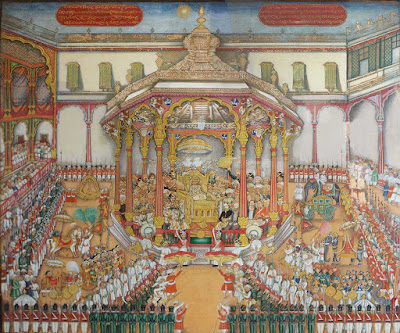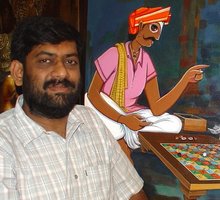Royal Weddings – an affair to remember
“God created the Maharajas to provide a spectacle to humanity” wrote Rudyard Kipling. And what a royal spectacle they were, their lives, the stuff dreams are made of, their alliances and misalliances and of course their fabulous and fabled weddings. Vintage photographs of some of the royal weddings show the bridal couple simply dripping with ruby, emerald, sapphire and diamond studded jewellery.
Little wonder that India was and continues to be known as the ‘land of Maharajas’ and their weddings are 'heavenly spectacle on earth.’
We are about to witness one such royal wedding, that of Yaduveer Krishnadatta- Chamarajendra Wadiyar with Trishika Kumari on June 27th/28th. Incidentally the young couple got engaged in May 2013 and their engagement was blessed so it is said by the Late scion of the Wadiyar dynasty, Srikantadatta Narasimharaja Wadiyar and his wife Pramoda Devi Wadiyar.
 |
| 1898. Royal couple in regal finery. Maharajakumari Cheluvajammanni avaru, sister of H.H. Krishnaraja Wadiyar IV with her consort Sri Lakshmi Kantharaj Urs.Collection: Ramsons Kala Pratishtana, Mysuru |
What is it about a royal wedding that makes the spectator go ‘Ooooh’ with a gasp of wonder?
The formal wedding photograph of Krishnaraja Wadiyar IV and Pratapa Kumari taken on June 6th 1900, gives a glimpse of the opulence surrounding the wedding.
Following the various formalities, the newly wedded couple were on June 14th taken in as grand a procession as the Dasara with all its fanfare. A note about the wedding was sourced from the India Office Records (Govt of UK). It says...
“Grand procession commenced at 10 pm with the Maharaja seated in the gold ambari on a magnificent state elephant. After leaving the fort, it proceeded through the main streets of the town and reached the palace around 1 am next day for the wedding ceremony.” The pity is that there is no photographic evidence of the crowds that thronged the street to rejoice in their Maharaja’s wedding to a Princess from the ‘North.’ However, the oil on canvas portrait of the young couple by the celebrated artist Raja Ravi Varma captures the opulence of the occasion.
Another entry of 1910 states that nearly 5000 people thronged the palace premises to witness the ritual of 'Kashi Yatre' performed at Yuvaraja Kanteerava Narasimharaja Wadiyar's wedding within the fort.
It is curious to discover that some of the Mysore Royals are ‘matrimonially connected’ to Royal families in the northern regions of Rajasthan, Gujarat and Madhya Pradesh.
The genealogical chart of the Mysore Royal House right from the reign of Chamarajendra Wadiyar X (ruled 1881–1895) until the present day indicates marriage alliances were being forged with Kshatriya kingdoms from the North. These exogamous marriages have been increasing since the end of the 19th Century.
In the book, 'Speeches of Dewan Kantharaje Urs' it is mentioned that H.H. Chamarajendra Wadiyar was desirous of finding Rajput grooms for his charming daughters. However, the first exogamous marriage was between Krishnaraja Wadiyar IV, son of Chamarajendra Wadiyar, and a Rajput princess from the north.
After Chamarajendra’s death, the dowager Maharani Kempananjammanni Vani Vilasa Sannidhana who became the Regent on behalf of her young son Krishnaraja Wadiyar IV sought the British Resident’s assistance to secure an alliance. The Resident, W. Macworth Young, agreed, and sent several letters to the other British Residents and Agents in Rajputana, Central India and Bombay Presidency in December 1895.
The Residents and Agents claimed that the Rajput rulers were not convinced that the Mysore family belonged to their caste, and it is noted that there would be difficulties in effecting a matrimonial alliance with Mysore unless a beginning could be made by marrying a Mysore princess to a Rajput chief. This too seemed to be an uphill task. Meticulous minutes by the Assistant Resident point out to one proposal that had to be vetoed because of demands of a dowry! This proposal came from the Maharao of Kota, Mahendra Umaid Singh II to marry a princess of Mysore. The Maharao wanted a dowry of Rs 5,00,000, this was a huge amount of money considering that the civil list of the Mysore Maharaja, which was one of the largest amongst Indian princes, was at that time only Rs 14,00,000. The alliance failed to materialise. (India Office Records, Govt of UK).
Again we take recourse to the Resident’s minutes which states that the late Maharaja Chamarajendra Wadiyar had met the Raja of Morvi, Thakur Waghji Ravalji II, and offered one of his daughters to the son of Morvi ruler. But this proposal too was dropped when it was discovered that the Mysore and Morvi families belonged to the same gotra.
The much sought after Rajput alliance came when Nalwadi Krishnaraja Wadiyar’s marriage took place with H.H. Maharani Lakshmivilas Sannidhana Pratapa Kumari Devi ammani avaru who belonged to a family of Parmar Rajputs of Saurashtra.
Later several alliances with ruling Rajput families were forged. For example all three daughters of Yuvaraja Kanteerava Narasimharaja Wadiyar, had been married off to Rajput royal families outside the State. Princess Sujayakanthammanni and Princess Vijayadevi had been married into the royal houses of the principalities of Sanad (Baghela Rajputs) and Kotada Sangani (Jadeja Rajputs) respectively in Gujarat. However, the third sister, Maharajakumari Sri Jayachamundammanni had married the Maharaja of Bharatpur in Rajasthan, the family belonged to the Sinsiniwar Jat lineage.
The wedding of Jaya Chamarajendra Wadiyar may be said to be the last of the royal weddings. The first marriage which took place at the Kalyana Mantap of the Palace on May 15th 1938 was to Maharani Satya Premakumari Devi-ammanni avaru, the daughter of Pratap Singh Deo Bahadur of Jigni who are Bundela Rajputs.
The second marriage of Jaya Chamarajendra Wadiyar to Maharani Tripurasundari Devi ammanni avaru, daughter of Balananja Raje Urs of the Mysore State Forces was also celebrated with a lot of fanfare. There was great rejoicing throughout the State, and special services were held and prayers offered in all the important religious institutions in the State and at Tirupathi.
Buntings and banners had been put up. 'Long Live the Maharaja’ were hung across the palace Jayamartanda Gate and all along the main streets and the processional route .At the appointed time Jaya Chamarajendra along with relative and courtiers walked out of Palace stopping only to feed some sugar cubes to the bedecked white stallion. Then seated in the howdah is taken in procession.
The Rajput connections continued, Maharajakumari Kamakshi Devi is married into the royal family of Wadawan in Gujarat. Her husband Rajakumar Atmanya Devji belongs to a family of Jhala Rajputs. Likewise, Maharajakumari Vishalakshi Devi is married to Rajakumar Gajendra Singhji who is a Rathore Rajput from Auwa, Jodhpur.
Royal processions were also taken out during the weddings of the daughters of Jaya Chamarajendra Wadiyar, Gayatri Devi, Meenakshi Devi and Kamakshi Devi. The marriages were solemnised in the Kalyana Mantap of the Palace. However, when Srikantadatta Narasimharaja Wadiyar married Pramoda Devi in 1976, there was no procession due to various reasons but the wedding by itself was an opulent affair.
Incidentally, the biological aunt of Yaduveer, Kirtimalini Devi, is married to Shailendra Singh, another Bundela Rajput from the principality of Ajaigarh.
When Yaduveer weds Trishika Kumari, another Rajput connection of the Wadiyars will be forged. She belongs to the Ahra Guhilot clan of Sisodia Rajputs who are descendents of Maharanas of Mewar.
Perhaps the Maharajas of Mysore not being extravagant and not parsimonious either, have always celebrated their marriages with just amount of graciousness that bespokes of royalty. The scion of the Wadiyar legacy, Yaduveer Krishnadatta Chamarajendra Wadiyar with Trishika Kumari also promises to be an affair to remember.
----------------------------------------------------------------------------
Royal Weddings
Another fairy tale royal wedding that took place in 1946 was the wedding of Princess Prem Kumari, the eldest daughter of Maharaja Sawai Man Singh of Jaipur to Yuvraj Jaideep Singhji of Devgadh Baria. This was the first wedding of Maharaja of Jaipur’s daughter in almost 100 years. So the celebrations were grand. All major royal houses were invited. The logistics and catering arrangements were prodigious and the preparations were made with military-like precision. The book of instructions to the Jaipur Palace employees was about two inches thick, detailing every party, festivity, ceremony and entertainment and containing programs for each group of guests and their staff. Even the menus for the servants and vantage points assigned to them for watching the processions were carefully worked out. The wedding festivities lasted for around two weeks.
The 1948 wedding of Princess Rajendra Kanwar of Jodhpur and Yuvraj Fatehsinhrao Gaekwad of Baroda was meticulously planned. A 12-man committee was formed to look after the wedding and logistics. Maharaja Hanuwant Singh personally supervised the marriage of his sister. The massive Umaid Bhawan palace and Meherangarh fort specially decorated for the wedding. Wedding reports state that the 4500 wedding guests were accommodated and the catering was done by 60 butlers and 125 English style cooks. There was a grand ceremonial procession through the streets of Jodhpur. This was followed by the main ceremony at Umaid Bhawan. The traditional Vedic ceremony lasted for two and half hours while the guests enjoyed cocktails and raucous folk music (Bollywood had not yet come into existence). This was followed by series of receptions. The total cost of the wedding? A whopping 1.4 million dollars and this was in 1948!
Cut to the present and we have the wedding of Rajkumari Shivatmika Kumari, the elder sister of Trishika who married Tikka Saheb Jaideepsinhji Mandhattasinhji (Jaideep Jadeja) of Rajkot on January 24th 2015 in Bangalore. Shivatmika and Trishika’s mother is Maheshri Devi, the Rajkumari of Vizianagaram and she has been living in Bengaluru.
Rajkumari Shivatmika’s wedding with Jaideep Jadeja began with a week of traditional festivities in Rajkot, a still sleepy dusty town of less than a million inhabitants. The seven day wedding celebrations culminated in an 8 km long procession through the main streets that had caparisoned camels, horses and elephants and the Yuvaraj Jaideep Jadeja rode in the golden howdah secured on the back of the bedecked Ambari elephant in the wedding procession known as ‘Fuleka.’ All the royal guests dressed in traditional attire were ferried in a fleet of 50 vintage cars that included a Buick Super, Hillman Minx, Oldsmobile Dynamic 76 Series, Chevrolet Phaeton Master Eagle Convertible Golden, Chevrolet Impala, Chevrolet Bellaire and a Willys Station Wagon.
- This article appeared in the Star Weekend Supplement of the popular evening newspaper of Mysore, 'Star of Mysore' on 25 June 2016, few days before the wedding of current scion of Wadiyar, Yaduveer Krishnadatta Chamaraja Wadiyar with Trishika Kumari



























